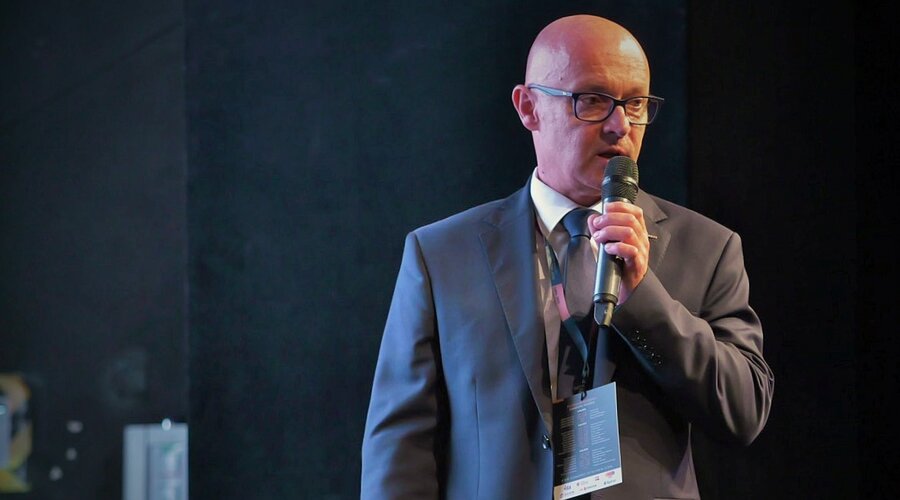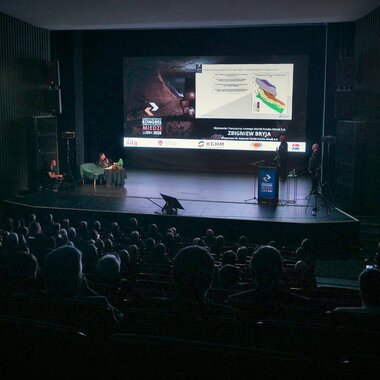KGHM summarises the International Copper Mining and Smelting Congress
Dozens of papers, hundreds of participants and visitors, a unique exhibition of mining machinery. The International Copper Mining and Smelting Congress under the Honorary Patronage of Andrzej Szydło, President of the Management Board of KGHM Polska Miedź S.A., has ended in Lubin. This is the most important event in the non-ferrous metals industry, which has been attracting scientists, practitioners and experts from Poland and around the world for many years.
Experts for the future
Nearly 450 participants of the Congress were able to listen to 75 papers, presented in 11 sessions. The discussions included the resource base and prospects for copper ore mining, the conditions of copper mining and smelting in the global economy and the technical aspects of mining production.
The participants also addressed the topics of accompanying metals recovery technology, non-ferrous metals processing under conditions of energy transition, risk prevention and organisation and safety at work.
The congress was accompanied by a very popular exhibition of mining and smelting machinery, which took place at the KGHM Head Office in Lubin. Many leading manufacturers of specialised solutions participated. The KGHM Group was represented KGHM ZANAM, CBJ, Inova and Nitroerg.
When opening the Congress, Andrzej Szydło, President of the Management Board of KGHM Polska Miedź S.A., indicated that the purpose of the event was to seek technological solutions in the areas of mining, smelting, refining and processing, among others, in order to be able to cope with the increasingly difficult conditions of mining
and production. ‘The discussion panels and papers should provide an inspiration to make sure that every gram, every kilogram, every tonne of copper, silver, lead or nickel is mined efficiently’.
About copper and KGHM
‘If we look at KGHM, our advantage is that we are complete’, said Andrzej Szydło, President of the Management Board of KGHM Polska Miedź S.A. ‘We can prospect and identify deposits, we can mine copper ores. We then enrich them and melt them down in a very efficient way in our smelters. We are an integrated process line that includes mining, processing and metallurgy. These elements have worked together increasingly well over the years. (...) This is why KGHM, as one of the few mining companies in Europe, is doing well’, stressed Andrzej Szydło. ‘The reserves of all the world's raw materials will slowly become depleted and increasingly difficult to reach. There is no question of a long-term decline in commodity prices, not just copper. There will come a point in the future when 90% of the copper supply to the market will not be copper dug deep underground or from open pit mines. That 90% will come from recycling. (...) Our task, as KGHM staff, the scientific community and the non-ferrous metals industry at large, is to optimise production so that it is cheaper and keeps up with regulations. So that KGHM can supply copper to the market for the next 30, 40 years’, he added.
‘The integrated process line certainly gives us an advantage, which comes from the commercial margins we obtain on the final products. It is also a challenge for us because we constantly have to think how to satisfy the appetite of our smelters for our own concentrates. We are constantly talking about new divisions, exploration, new concession areas’, noted Mirosław Laskowski, KGHM's Vice President of the Management Board for Production. ‘We are in the top 7 in terms of copper production in the world, in the top 2 in silver production and in the top 3 in terms of rhenium’, he concluded.
Key challenges for the industry
‘What limits us today are the technical possibilities and the unit cost of copper mining. If we overcome these two barriers, we will be able to produce copper in our country for a very long time to come. It is a strategic raw material. Poland is responsible for half of Europe's mined copper production, and I think that for a very long time to come everyone in Europe will need our copper’, said Zbigniew Bryja, KGHM's Vice President of the Management Board for Development. ‘The biggest challenge we are facing is the ability to mine at large depths. This is not only a matter of the deposit being less thick, but also of the high temperatures prevailing there. What is needed is a new generation of machines, the introduction of automation and, in time, perhaps autonomous machines’, he added.
The organisers of the International Copper Mining and Metallurgy Congress were: the Lubin Branch of the Association of Mining Engineers and Technicians, the Polish Copper Employers' Association, and the Association of Non-Ferrous Metals Engineers and Technicians at the Głogów and Legnica Copper Smelters, with the participation of the Wrocław University of Technology. Patronage of the Congress was assumed by the the President of the Management Board of KGHM Polska Miedź S.A. KGHM Polska Miedź S.A. was the Main Partner of the Congress.














